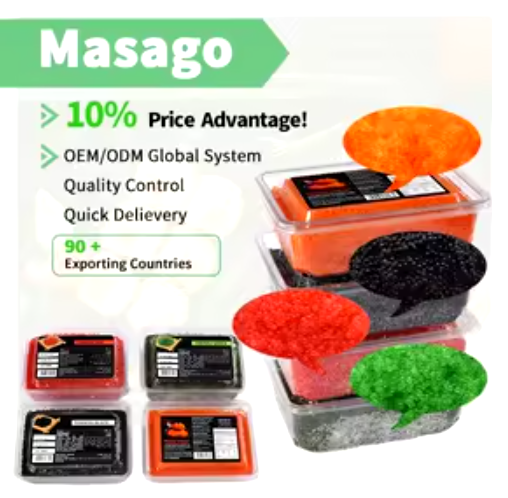BOURSESSENEGAL – Masago, a type of fish roe, has gained popularity in culinary circles for its unique flavor and texture. Often found in sushi and other Asian dishes, masago offers a burst of taste that can elevate any meal. In this post, we’ll explore what masago is, its nutritional benefits, culinary uses, and how to incorporate it into your diet.
What Is Masago?
Masago comes from the capelin fish, which is primarily found in the North Atlantic. The roe, or eggs, are small, typically orange in color, and have a slightly crunchy texture. Masago is often confused with other types of fish roe, such as caviar and tobiko, but it has distinct characteristics that set it apart.
The Difference Between Masago, Caviar, and Tobiko
While all three are types of fish roe, they differ in origin and taste:
- Caviar: Typically refers to roe from sturgeon. It’s known for its rich flavor and higher price point.
- Tobiko: Comes from flying fish. Tobiko is larger than masago and has a smoky flavor. It often comes in various colors due to flavoring agents.
- Masago: Sourced from capelin, masago is smaller than tobiko and has a milder taste. It offers a delightful pop when eaten.
Understanding these differences helps you appreciate masago’s unique qualities and how it fits into various dishes.
Nutritional Benefits of Masago
In addition to its delightful taste, masago offers several nutritional benefits. Here’s why you might want to include it in your diet:
High in Omega-3 Fatty Acids
Masago contains a healthy dose of omega-3 fatty acids. These essential fats support heart health, improve brain function, and reduce inflammation in the body. Incorporating omega-3s into your diet can lead to a lower risk of chronic diseases.
Packed with Vitamins and Minerals
Masago is rich in several vital nutrients, including:
- Vitamin B12: Important for nerve function and the production of red blood cells.
- Vitamin D: Supports bone health and the immune system.
- Iron: Essential for transporting oxygen in the blood and maintaining energy levels.
Low in Calories
For those watching their calorie intake, is a great option. A typical serving contains only about 40 calories, making it a flavorful addition to your meals without the guilt.
Culinary Uses of Masago
Masago’s versatility shines in various culinary applications. Let’s explore some popular ways to use it in your cooking.
Sushi and Sashimi
One of the most common uses for masago is in sushi rolls. It adds a delightful crunch and a burst of flavor, enhancing the overall experience. Chefs often sprinkle on top of sushi rolls or mix it into the rice.
Masago in Sauces and Spreads
You can also incorporate into sauces and spreads. For example, mixing it into mayonnaise creates a flavorful seafood sauce perfect for sandwiches or salads. This addition elevates the dish and introduces an exciting texture.
Masago Topping for Rice Dishes
Try adding as a topping for rice dishes. It complements the flavors of fried rice, poke bowls, or rice salads beautifully. The small bursts of flavor from the roe provide a nice contrast to the dish’s base.
Salads and Appetizers
can enhance salads and appetizers, too. Consider adding it to a seafood salad or using it as a garnish for deviled eggs. Its vibrant color and unique taste can make any dish visually appealing.
How to Choose and Store Masago
When purchasing masago, consider the following tips to ensure you get the best quality:
Freshness Matters
Always check the expiration date on the packaging. Fresh masago will have a bright color and a pleasant, briny aroma. Avoid any products that appear dull or have an off smell.
Look for Quality Brands
Some brands offer higher quality masago than others. Researching reputable brands can make a difference in flavor and texture. Many specialty grocery stores and Asian markets carry quality products.
Proper Storage
Once opened, store masago in an airtight container in the refrigerator. It’s best consumed within a few days for optimal freshness. If you need to store it longer, consider freezing it, but be aware that this may affect its texture.
Health Considerations and Allergies
While offers many benefits, it’s essential to be aware of potential health concerns.
Allergies to Fish Roe
Some individuals may have allergies to fish roe or shellfish. If you have a known allergy, consult with a healthcare professional before trying or any similar products.
Sodium Content
can contain a significant amount of sodium, depending on how it’s processed. If you are watching your salt intake, check the nutrition label and consume it in moderation.
Where to Buy Masago
You can find masago in various places:
Asian Grocery Stores
Many Asian grocery stores carry fresh , often in the seafood section. These stores usually offer several brands, giving you plenty of options to choose from.
Online Retailers
If you can’t find locally, consider purchasing it online. Many retailers offer shipping for specialty ingredients, making it easy to get what you need right to your door.
Sushi Restaurants
Some sushi restaurants may sell as a take-home item. Ask your local sushi chef if they can provide you with some.
Conclusion: Embrace the Flavor of Masago
Masago is more than just a colorful topping; it’s a flavorful ingredient that can elevate many dishes. From sushi to salads, its unique taste and nutritional benefits make it a valuable addition to your kitchen.
Incorporate into your meals to enjoy the burst of flavor it brings. Whether you’re a seasoned chef or just starting in the kitchen, this delightful fish roe can inspire your culinary creations.
So, the next time you’re at the grocery store or dining out, keep an eye out for masago. It may just become your new favorite ingredient
REFERENCE : https://www.health.com/



